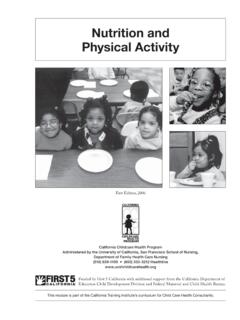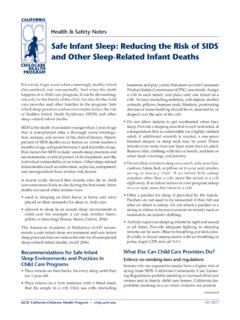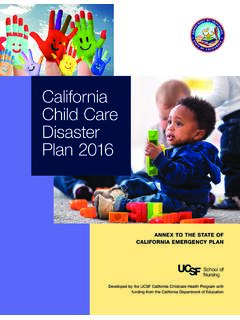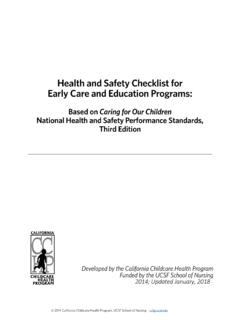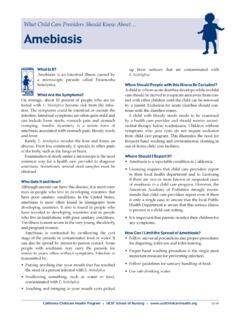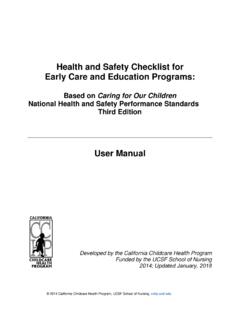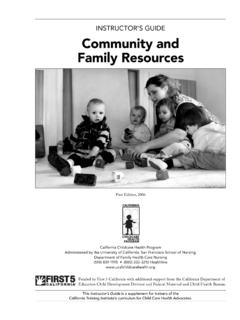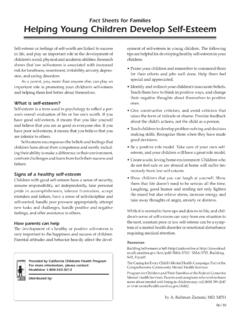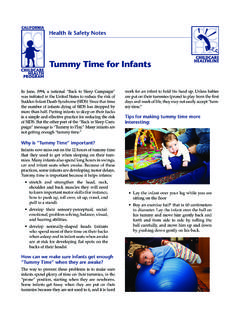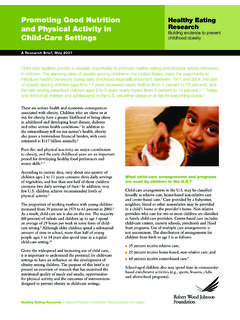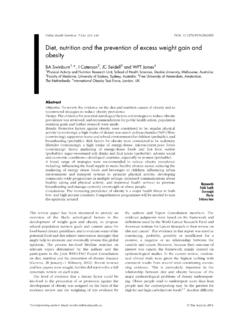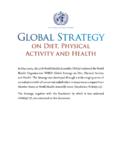Transcription of Nutrition and Physical Activity - University of California ...
1 This module is part of the California Training Institute s curriculum for Child Care Health and Physical ActivityCalifornia Childcare Health ProgramAdministered by the University of California , San Francisco School of Nursing, Department of Family Health Care Nursing(510) 839-1195 (800) 333-3212 by First 5 California with additional support from the California Department of Education Child Development Division and Federal Maternal and Child Health Edition, 2006 AcknowledgementsTh e California Childcare Health Program is administered by the University of California , San Francisco School of Nursing, Department of Family Health Care wish to credit the following people for their contributionsof time and expertise to the development and review of this curriculum since e names are listed in alphabetical order.
2 Main Contributors Abbey Alkon, RN, PhDJane Bernzweig, PhDLynda Boyer-Chu, RN, MPHJudy Calder, RN, MSLyn Dailey, RN, PHNJ oanna Farrer, BA, MPPR obert Frank, MSLauren Heim Goldstein, PhDGail D. Gonzalez, RNJan Gross, BSN, RNSusan Jensen, RN, MSN, PNPJ udith Kunitz, MAMardi Lucich, MACheryl Oku, BATina Paul, MPH, CHESPamm Shaw, MS, EdDMarsha Sherman, MA, MFCCKim To, MHSE ileen Walsh, RN, MPHS haron Douglass Ware, RN, EdDMimi Wolff , MSWR ahman Zamani, MD, MPHE ditorCatherine Cao, MFACCHP StaffEllen Bepp, Robin Calo, Sara Evinger, Krishna Gopalan, Maleya Joseph, Cathy Miller, Dara Nelson, Bobbie Rose, Griselda Th omas Graphic DesignersEdi Berton (2006)Eva Guralnick (2001-2005)
3 California Childcare Health ProgramTh e mission of the California Childcare Health Program is to improve the quality of child care by initiating andstrengthening linkages between the health, safety and child care communities and the families they of this curriculum were adapted from the training modules of the National Training Institute for Child Care Health Consultants, North Carolina Department of Maternal and Child Health, Th e University of North Carolina at Chapel Hill; by First 5 California with additional support from the California Department of Education Child Development Division and Federal Maternal and Child Health and Physical ActivitynCalifornia Training InstitutenCalifornia Childcare Health Programn1 LEARNING OBJECTIVESTo describe the major Nutrition issues aff ecting children and providers in early care and education (ECE)
4 Describe the health benefi ts of Physical Activity for children in ECE identify safe practices in food handling, cooking and storage to prevent foodborne describe three ways a Child Care Health Advocate (CCHA) can assist ECE programs meet the Nutrition and Physical Activity needs of identify the primary Nutrition and Physical Activity resources available to assist and support ECE providers and and Physical Activity are an important part of a healthy childhood. For good health, children need a variety of safe and nutritious foods, along with daily Physical Activity .
5 Balanced Nutrition and Physical Activity improve not only Physical health, but also children s growth, mood, quality and quantity of sleep, and ability to learn. Caring for Our Children: National Health and Safety Performance Standards: Guidelines for Out-of-Home Child Care Programs, Second Edition (CFOC) (American Academy of Pediatrics [AAP], American Public Health Association & National Resource Center for Health and Safety in Child Care, 2002) notes that nour-ishing and attractive food is the cornerstone for health, growth, and development as well as developmentally appropriate learning experiences (Standard ).
6 2nNutrition and Physical ActivitynA Curriculum for Child Care Health AdvocatesINTRODUCTIONAt home and in ECE programs, young children develop preferences and habits for foods and activi-ties (Birch, 1998). Th ese early habits are likely to continue for the rest of their lives. Children look to adults as models for the foods they prefer (Fisher & Birch, 1995). Th us, ECE staff have a chance to infl u-ence children s food preferences and experiences in ways that will promote health by off ering foods that are safe, nutritious and of ECE Providers(Graves, Suitor & Holt, 1997) Provide a variety of foods that help children grow and develop.
7 Provide food that is safe to eat. Provide food that respects each child s culture. Pay attention to each child s eating behavior tell the child s parent if the child is not eating enough of the right kinds of food. Prevent injuries when preparing, handling and eating food. Bottlefeed infants whenever they are hungry. Off er food every 2 to 3 hours to prevent children from feeling hungry. Off er snacks only at scheduled times. Give children enough time to eat (30 minutes is usually enough). Provide enough help so that children feel relaxed when they eat.
8 Have a friendly, comfortable place for eating make food time fun time. Help children feel good about nutritious foods. Help children develop a habit for eating the right kind and amount of food. Take care of yourself eat well so that you stay healthy, feel good and have energy to take care of children. Be a role THE CCHA NEEDS TO KNOWWhy Young Children Are at Risk Young children depend on adult caregivers (par-ents, family members, ECE providers) to teach them healthy eating habits and to off er them good food choices. If children see adults eating foods that are poor in nutrients, they may copy these unhealthy habits (Fisher & Birch, 1995).
9 Children who do not get enough nutrients, such as those who overeat unhealthy foods, may become obese and have serious health problems as teenagers and adults. Children must eat food that is rich in calcium, iron and other nutrients because they often eat small portions of food. Some parents may prepare foods based more on convenience than on Nutrition . Meals made from packaged foods are usually high in additives and preservatives, and poor in nutrients, compared to more planned meals that may take time to prepare. Children are targets of many marketing strate-gies by food companies.
10 Children s television shows are often sponsored by makers of pro-cessed foods and highly sweetened snacks. Children are vulnerable to these advertisements because they do not yet have the ability to recog-nize advertisements that are trying to persuade them to eat unhealthy the Research Tells Us Increasing the proportion of infants in a com-munity who are exclusively breastfed seems to be an eff ective way of reducing infant illness (Wright, Bauer, Naylor, Sutcliff e & Clark, 1998). ECE staff can aff ect their community s health status by supporting the eff orts of mothers who continue to breastfeed after returning to work or school.
